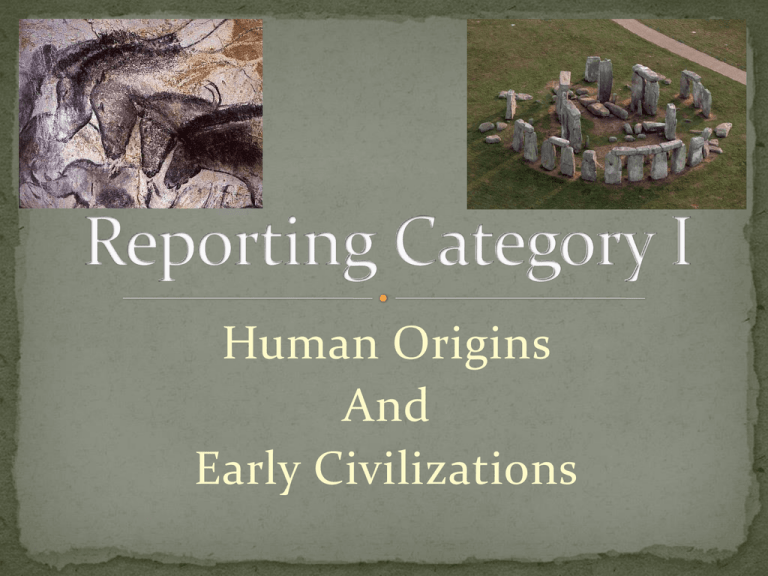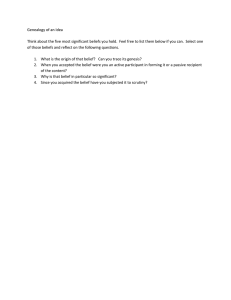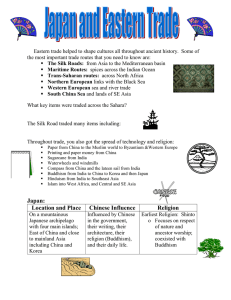Human Origins And Early Civilizations
advertisement

Human Origins And Early Civilizations - Hunter Gatherer societies lived during the - - OLD Stone Age (PALEOLITHIC ERA) They were NOMADIC, migrating in search of FOOD and WATER. Learned how to make and use FIRE. Created the first tools out of ROCK and BONE Lived in small groups known as CLANS Developed an ORAL language Created “CAVE” art - PERMANENT societies (villages) developed - - in the NEOLITHIC Era (NEW Stone Age) Developed AGRICULTURE (domesticated plants) DOMESTICATED animals Used ADVANCED tools Made POTTERY Developed WEAVING skills - Archeologist study past cultures by looking at - - HUMAN remains, settlements, FOSSILS, and ARTIFACTS. Use tests such as RADIO CARBON DATING STONEHENGE, in England, was begun in the NEOLITHIC AGE, and finished in the BRONZE AGE ALEPPO and JERICHO were early cities in the FERTILE CRESCENT CATALHOYUK is an early city in Anatolia or ASIA MINOR STONEHENGE JERICHO ALEPPO CATALHOYUK - POLYTHEISM was practiced by most early civilizations - Mesopotamia: Angry, Vengeful Gods - Egypt: Happy AFTERLIFE - Pyramids: Tombs for PHAROAHS - PHAROAHS: GOD KINGS - MONOTHEISM was practiced by the HEBREWS - ABRAHAM: 1st Covenant (PROMISE) with God - - From Mesopotamia Holy Land – Canaan – Promised by God Moses: Led Hebrews out of EGYPT JERUSALEM: Holy city of Hebrews MONOTHEISTIC: Belief in one God TORAH: Holy Book of Judaism The moral and religious code of conduct for Judaism is the TEN COMMANDEMENTS DIASPORA: The Jews were exiled (kicked out of) from Israel in 587 BCE by the Babylonians CUNEIFORM STAMPS & SEALS HEIROGLYPHICS ORACLE BONES PHOENICIAN ALPHABET - Practiced a policy of TOLERANCE towards conquered people: CYRUS - Developed IMPERIAL Bureaucracy - Constructed a Road System: The ROYAL Road - ZOROASTRIANISM – Religion of Persian Empire - - MONOTHEISTIC - - TWO opposing forces in the universe Good vs. EVIL - Physical Barriers such as the HIMALAYAS, the HINDU KUSH, and the INDIAN OCEAN made invasion difficult. - The INDUS and GANGES Rivers were the two most important rivers in the Indian Subcontinent - Mountain passes in the HINDU KUSH allowed for MIGRATION in the Indian Subcontinent (ARYANS) - Early Cities included MOHENJO-DARO and HARAPPA - - Planned Cities (GRID Systems) - - PLUMBING MOHENJO DARO HARAPPA - ARYANS: Invaders that entered through the KHBYER PASS and settled in the Indus River Valley - CASTE SYSTEM: rigid social structure that influenced all social interactions and choices of occupations - MAURYAN Empire: ASOKA - Continued political Unification of India - Contributions - - Spread of BUDDHISM - - Free Hospitals - - Roads - GOLDEN AGE of classical Indian Culture - HINDUISM - Contributions - Math (concept of Zero) - Medical Advances - Astronomy - New Textiles - Literature - Belief in many forms of one god - REINCARNATION: Rebirth based on Karma - KARMA: Belief that your thoughts and actions result in future consequences - Sacred writings of Hinduism are the VEDAS and the UPANISHADS - Spread along major trade routes - Founder was Siddhartha Gautama (Buddha) - FOUR NOBLE Truths - EIGHTFOLD Path - ASOKA’S missionaries and their writings spread Buddhism from India to other countries in Asia - The SILK ROAD facilitated trade and contact between China and other cultures as far away as Rome - Contributions of Classical China - Civil Service System - Paper - Silk - Porcelain PAPER SILK CIVIL SERVICE PORCELAIN - Belief that humans are GOOD, not Evil - Respect for ELDERS (Filial Piety) - Code of POLITENESS (still used today) - Emphasis on EDUCATION - ANCESTOR Worship - FIVE Relationships - Belief in Humility - Simple Life and Inner Peace - Harmony with NATURE - YIN and YANG: Represent Opposing Forces in Nature - Symbol used in Taoism & Confucianism - Chinese forms of BUDDHISM spread throughout Asia


